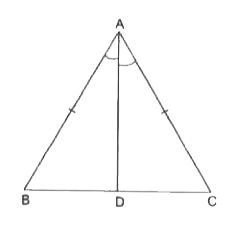Prove that the circle drawn on any one of the equal sides of an isosceles triangle as diameter bisects the base.
Video Solution
Text Solution
Given: △ABC is an isosceles triangle with AB=AC. A circle is drawn taking AB as diameter which intersects the side BC at D
To prove: BD=DC
Construction: Join AD
Proof: ∠ADB=90∘[Angle in a semi-circle is right angle]
∠ADB+∠ADC=180∘
⇒∠ADC=90∘
In △ABD and △ACD
AB=AC [Given]
∠ADB=∠ADC
AD=AD [Common]
∴△ABD≅△ACD [RHS congruence criterion]
∴BD=DC [By CPCT]
Hence Proved.
|
Topper's Solved these Questions
Similar Questions
Knowledge Check
Each of the equal sides of an isosceles triangle is 13 cm and its base is 24 cm. The area of the triangle is
A156 cm2B78 cm2C60 cm2D120 cm2Each of equal sides of an isosceles triangle is 13 cm. If the length of base is 24 cm then its area is
A50cm2B60cm2C55cm2D65cm2
Prove that the perpendiculars drawn from the vertices of equal angles of an isosceles triangle to the opposite sides are equal.
View SolutionProve that the bisector of the vertical angle of an isosceles triangle bisects the base at right angles.

View SolutionProve using vectors: The median to the base of an isosceles triangle is perpendicular to the base.
View SolutionFind the area of an isosceles triangle having the base x cm and one side y cm
View SolutionThe line drawn from the midpoint of one side of a triangle parallel to another side bisects the third side.
View Solutionprove that the circle drawn on any focal distance as diameter touches the auxiliary circle in an ellipse
View Solution
